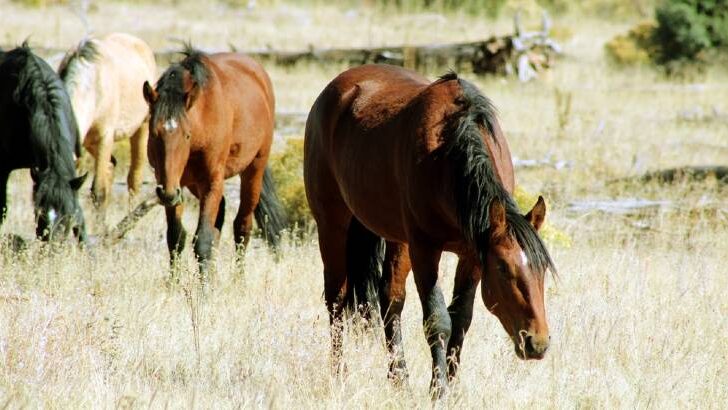Affiliate Disclaimer
As an Amazon Associate I earn from qualifying purchases. It helps me keep the website going. Thank you for your support.
Have you, at some point, looked at the expensive food rejected by your fussy horse and told the ungrateful culprit that hungry horses in the wild would love to eat it? But would they…? What do horses eat in the wild when they don’t have access to hay, nutritious hard feeds, and lush pastures?
When you think of wild horses, you probably have an image of unkempt horses trying to live on a sparse diet of whatever they can forage. However, although the unkempt part may be true, horses in the wild – eating predominantly native grasses, and topping it up with shrubs, and other vegetation – are eating close to what they were originally designed to eat.
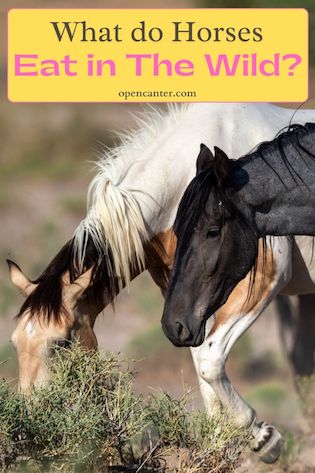
The Natural Diet of Wild Horses
The majority of horses and ponies that live in the wild today are not truly wild. They are managed, semi-feral populations that, for various reasons, run free in reserves, national parks, and other controlled environments.
Even so, without access to cultivated feeds and forages, they have to be much more opportunistic. That means eating whatever vegetation is available when it’s available. Which may be weeds, shrubs, trees, herbs, and tough native grasses…
What Do Horses Eat In The Wild In North America?
Although originally native to North America, horses disappeared completely from that continent around 12,000 years ago. Fortunately, some populations had migrated to Europe via the Bering land bridge between Alaska and Russia during the Pliocene (2 to 3 million years ago).
When sea levels rose 10,000 to 11,000 years ago after the last Ice Age, the Bering land bridge disappeared and all horses still in existence were then effectively ‘trapped’ in Eurasia.
They didn’t return to North America until the 1500s when Spanish settlers brought them over. Many subsequently escaped or were turned loose and today their feral ancestors are known as mustangs in North America, and by various other names in South America.
The Great Plains Mustangs of Central North America
Many of North America’s mustangs live on the Great Plains grasslands that stretch right up through central US into Alberta, Saskatchewan, and Manitoba in Canada.
They eat native grasses like bluestem (big and little), wild rye, and switchgrass. Like their ancestors, they also browse on available trees and shrubs when grasses are in short supply.
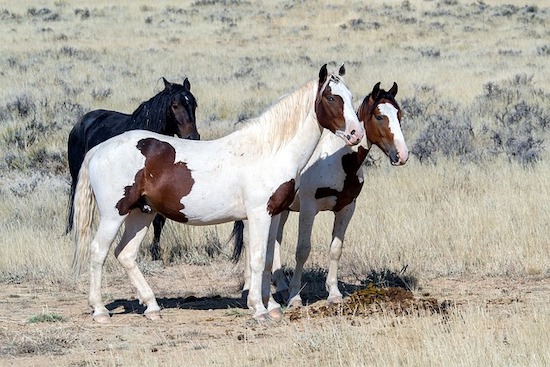
The Western US Mustangs
Wild horse populations are also found along the western US states but the climate is much drier and more desert-like, particularly in states like Arizona.
Mustangs in these areas survive by eating shrubs and trees – salt desert scrub, winterfat, rabbitbrush, juniper, and sagebrush along with blue bunch, squirreltail, and wheat grasses. They may also eat succulents like cacti in particularly arid environments.
North America‘s East Coast Wild Horses
There aren’t too many wild horses along the more populated east coast of America but the Chincoteague pony is one particularly famous breed that mostly lives wild.
This hardy pony lives on the islands of Assateague and Chincoteague off the Virginia and Maryland coasts. Although their precise ancestry isn’t known, they are thought to descend from horses originally brought to the islands by early settlers.
Over the centuries, these ponies have adapted to eating local island vegetation like salt marsh grasses, spike rushes, and cord grasses. They’ve also been known to eat bayberry, cedar, and wax myrtle. In winter, they dig down through the snow to get to the grass underneath or eat twigs and bark from trees.
What Horses Eat In The Wild In South America?
South America has several native horse breeds that are often allowed to roam wild when they’re not being used.
In most cases, the breeds are named after the areas in which they evolved i.e. the Pampas horses of the Pampas region in Argentina, the Pantaneiro horses in the Pantanal wetlands, and so on. Genetic research however indicates they all descend from Spanish stock brought to South America by the Conquistadors in the 1500s.
The Criollo
The Criollo is South America’s best-known breed, associated with the gaucho or cowboy and selectively bred for stock work. It’s also known as the ‘native horse of the Pampas’, a fertile region in Argentina also famous for the native Pampas grass that grows there.
When running wild, Criollo herds live in a range of habitats – forest, scrub, and grasslands. What they eat depends on what is available in their particular home range.
Those living on the Pampas for example eat the Pampas grass. Those living in forested and scrubby areas eat shrubs, trees, and whatever grasses they can find. Criollo horses have also been known to eat insects when they have to.
Paso Fino Horses
Herds of Paso Fino horses that live wild, or semi-wild, in the savannas and grasslands of Venezuela and Colombia eat the native grasses, shrubs, and herbs.
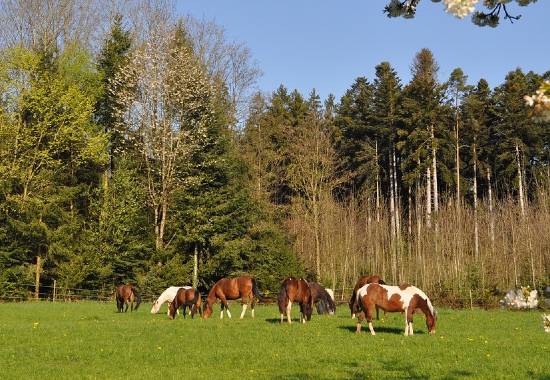
Pantaneiro Horses
Located right in the middle of South America, the Pantanal is the world’s largest tropical flooded grassland region. It’s also home to the Pantaneiro horses, a breed that has evolved here. These horses graze the wetland grasses, trees, and other native aquatic plants.
Corralero
The Chilean Criollo, or Corralero, is Chile’s version of the Criollo. Many of these horses live semi-wild in the mountainous regions of Chile, where they eat native grasses, shrubs, and herbs. Most though have owners, and their diets are supplemented with hay and other fodders as required.
Andean Horses
Andean horses living wild in the Andes Mountains eat shrubs, lichen, and grasses in their habitat but are also supplement-fed hay and fodder at certain times of the year.
Chilote Horses
The Chilote Horses that live in the wild on the Chiloe Archipelago also eat the herbs, grasses, and shrubs found throughout their habit. They will eat seaweed as well at low tide plus they get fed hay and fodder.
What Does The World’s Largest Population Of Feral Horses Eat In The Wild?
Ironically, a country that probably has one of the youngest horse populations in terms of how long they’ve been there also has the largest global population of feral horses! What these horses eat in the wild depends on where they live on this vast island continent.
The Australian Brumby
Horses arrived in Australia with the First Fleet in 1788. The ships, en route from England, picked up some horses from the Cape Colony in Africa when they called in for supplies before setting off on the final stage of their journey to the great land down under. Four mares, a stallion, a colt, and a filly survived the journey.
By 1800, the fledgling colony had around 200 horses. They were a mix of locally bred and additional imported stock. In 1804, there are reports of horses escaping into the bush, or being abandoned to run wild. Realistically though there were few fences to stop them!
Today some of Australia’s current population of 400,000 brumbies descend from stock brought in by early settlers. However, most have relatively recent origins, being descendants of domestic horses released into the wild as late as the mid-1900s.
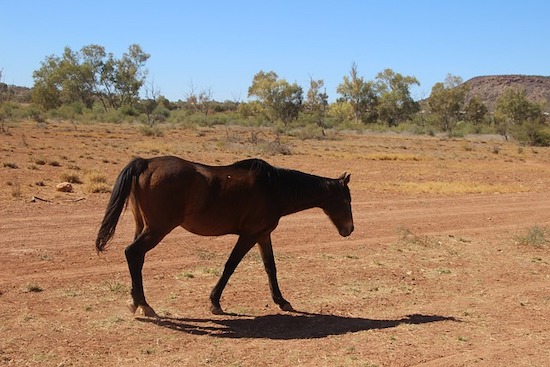
The Alpine Region Brumby
Famous brumby mobs, like the Snowy Mountain and Mount Kosciuszko brumbies, live in the Alpine regions of NSW and Victoria where they like to eat native alpine and snow grasses.
They’re also a common sight grazing grasses and vegetation along the road verges throughout the area. However, they’ll eat weeds, nuts and seeds, shrubs, bark, and even some types of eucalypt trees too.
Australia’s Top End Brumbies
Elsewhere in Australia, brumbies roam wild across Australia’s ‘top end’. There are huge tracts of tropical, subtropical, and semi-arid grasslands, savannas, and shrubby country across this region.
Mitchell grasses in particular grow prolifically there and are a large part of what horses eat in the wild here. However, brumbies also eat Spinifex, mulga, acacia, and saltbush when they need to.
Geraldton Pangare Brumbies
There is also a mob of unusual pangare colored brumbies living in the coastal sand dunes near Geraldton in Western Australia. They eat the coastal saltbush and other scrubby salt and sand-tolerant vegetation.
The Diet Of Wild Horses In New Zealand
‘Across the ditch’ from Australia, a protected and managed herd of around 400 Kaimanawa ‘Heritage’ horses live wild in the Kaimanawa Mountains in the middle of the North Island of New Zealand.
These horses are said to be descendants of Exmoor and Welsh Mountain ponies brought into the country by early settlers, and released into the wild in the 1870s.
The area in which the Kaimanawa horses live has vast tracts of tussock grasslands, particularly the native red tussock and pallens tussock.
Surveys of their habitat show that they feed extensively on these varieties of tussock along with snowgrass, and Kanuka and Manuka bushes but leave many other types of vegetation alone. However, this may be due in part to the fact that their numbers are now carefully controlled in line with what their habitat can sustain.
What Do Wild Horses Eat in Europe?
Like other parts of the world, most of the horses that run wild in Europe are, much like the native ponies that roam free over parts of England and Scotland, also managed herds.
Europe though has many native species of grasses, legumes, and shrubs that aren’t available to horses living in the wild elsewhere.
This includes some species of fescue, various types of meadow grasses, and legumes such as clovers. Although these do grow elsewhere, it’s usually under cultivated conditions where wild horses don’t go.
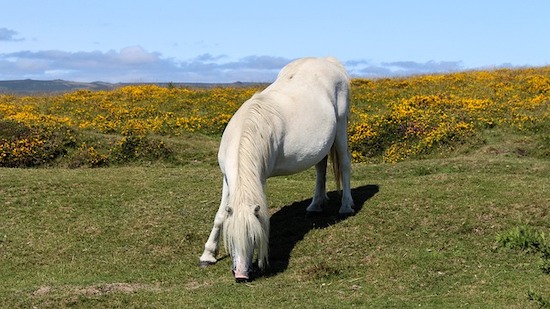
The Swampy Diet of The Horses Of The Carmague And Danube Delta
Some isolated groups of horses, like the famous white horses of the Carmague in southern France, have learned to survive in marshy swamps and wetland environments like the Rhone delta. They eat the marsh plants and reeds that grow in the salty wetlands.
Spartina or marsh/salt grass in particular grows well in the delta. It’s rich in magnesium, calcium, and potassium and forms a major part of the diet of the Carmague horses. They also eat a salt-tolerant succulent called glasswort (Samphire or Salicornia), and the tough woody goosefoot or fat hen weed.
Over in the Danube Delta in Romania, the Danube Delta horses likewise feel right at home running wild in their swampy wetlands. They too eat aquatic vegetation like reeds, rushes, and sedges as well as willow tree leaves and various other local wetland shrubs.
From Swamps and Wetlands To The Mountains …
The Pindos Pony from the Pindos Mountains in Greece is a good example of the horses and ponies that live in the mountainous regions of Europe.
Like other mountain horses and ponies, this very tough breed has adapted well to its harsh mountain home. The ponies eat native bluegrass and red fescue, juniper bushes, and like to spice things up a bit with wild oregano, sage, and thyme leaves.
Wild Ponies in the UK and Their Diet
The UK is famous for its beautiful native pony breeds, many of which still roam free in their traditional habitats.
The Dartmoor and New Forest ponies for example eat the grasses (purple moor, wavy hair), herbs (tormentil), and heathers that grow naturally across their native forest and moorland habitats. They’ll also eat hawthorn and gorse leaves, much as they’ve done for centuries.
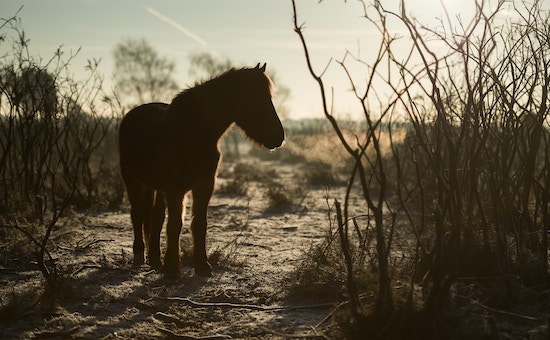
On their native Shetland Isles, the hardy Shetland pony not only survives very well on the sparse vegetation there but also knows how to supplement its diet with seaweed. And, like most ponies, they’ll eat twigs and leaves as well.
Horses Are Opportunistic Feeders No Matter Where They Live
Although horses are allowed to roam wild in other parts of the world, such as Africa and Asia, they’re not as common. Where they do, like horses everywhere, they’ll eat whatever grasses and other vegetation is available to them. What those are varies depending on region and climate.
Horses that live wild where it snows have likewise learned to adapt. They’ll eat exposed bushes and shrubs, and dig through the snow to get to the grass underneath. In some places, other animals, like deer, have been observed following horses so they can take advantage of the exposed grasses too!
Final Thoughts
Horses in the wild, or that are allowed to roam free, have been able to adapt extremely well to their environments. Although they do eat a variety of grasses and other vegetation depending on location and climate, research suggests that the bulk of what horses eat in the wild are grasses (80%) with shrubs and forbs making up the remainder.

